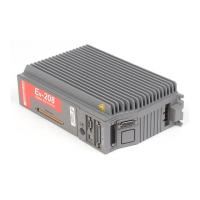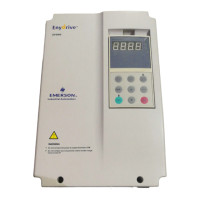138
Epsilon Eb and EN Drives Reference Manual
High Performance Gains, when enabled, make the system less forgiving in applications where
the actual inertia varies or the coupling between the motor and the load has excessive windup
or backlash.
Note
When using an external position controller, some applications will benefit in rare
instances by disabling High Performance Gains.
Position Error Integral
Position Error Integral is a control term that is effective only in Pulse mode which serves to
minimize following error especially at constant speed. This minimizes phase error between
master and slave when running in a line shaft or gearing application. It also helps maintain
accurate command execution during steady state or low frequency torque disturbances
(typically less than 10 Hz) or when holding a non-counterbalanced vertical load in position.
The adjustment parameter is Position Error Integral Time Constant which is available in the
Motor and Tuning Tabs of PowerTools. This parameter determines how quickly the drive will
attempt to eliminate the following error. The time constant is in milliseconds and defines how
long it will take to decrease the following error by 63%. (3 time constants will reduce the
following error by 96 %). The range for this parameter is 5 to 500 milliseconds. In certain
circumstances the value actually used by the drive will be greater than the value specified in
the Power Tools because the minimum allowed time constant value is a function of the
‘Response’ parameter. The formula is Min. Time Constant = 1000/Response. For example
with ‘Response’ set to 50, the minimum time constant value is 1000/50 = 20 msec. A higher
time constant value will minimize instability with more compliant loads such as long drive
shafts, or spring loads. A lower time constant setting will increase the response and will
stiffen the system.
Feedforwards
Feedforward gains are essentially open loop gains that generate torque commands based on
the commanded velocity, accel/decel and the known load parameters (Inertia Ratio and
Friction). Using the feedforwards reduces velocity error during steady state and reduces
overshoot during ramping. This is because the Feedforwards do not wait for error to build up
to generate current commands.
Feedforwards should be disabled unless the absolute maximum performance is required from
the system. Using them reduces the forgiveness of the servo loop and can create instability if
the actual inertia and/or friction of the machine varies greatly during operation or if the Inertia
Ratio or Friction parameters are not correct.
The internal feedforward velocity and acceleration gains are calculated by using the Inertia
Ratio and Friction parameters. The feedforward acceleration gain is calculated from the
Inertia Ratio parameter and the feedforward velocity gain is calculated from the Friction
parameter.
Artisan Technology Group - Quality Instrumentation ... Guaranteed | (888) 88-SOURCE | www.artisantg.com
